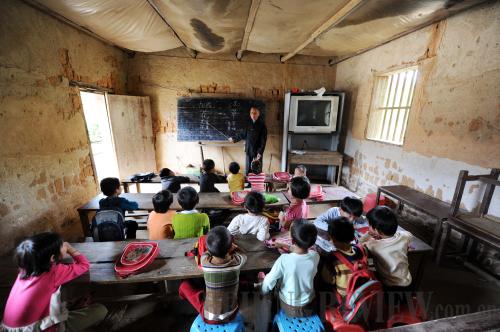Reviving Education in the Countryside
Beijing Review, May 28, 2013 Adjust font size:
 |
|
Lai Feng, a 75-year-old teacher, holds class at Guanbu Primary School in Anyuan County, east China's Jiangxi Province, on May 18, 2012. |
The Rongsheng Hope Primary School has witnessed a sharp drop in enrollment, declining from 180 students to only 30 in just three short years.
Once upon a time, this school in a remote village in northwest China's Gansu Province catered to children up to grade six, but today there are only first and second grades. The other four merged into a larger township primary school.
Since 2001, dropout rates have risen as rural school districts have been indiscriminately re-zoned and amalgamated into mass institutions. According to a National Audit Office (NAO) survey of 1,155 schools in 52 major counties released on May 3, the number of dropouts more than doubled to 8,352 in 2011 from 3,963 in 2006. From May to August last year, the NAO carried out random surveys of more than 25,000 schools in more than 1,200 counties across the country.
The surveys also revealed that unscrupulous merging has greatly reduced the total number of rural primary schools and forced a number of children to walk longer distances to and from places of learning.
About 4 percent of the 12.6 million non-resident students have to travel more than 6 km per day on foot or spend more on transport to get to school, according to a NAO report. More than 100,000 rural children, mainly in mountainous areas, have to walk more than 10 km, adds the report.
Increasing dropouts
Early in November last year, a report issued by the Beijing-based 21st Century Education Research Institute (CERI) claims that the primary school drop-out rate had rebounded to levels similar to those seen in the late 1990s, claiming that merging rural schools has caused students to drop out.
An average of 63 primary schools, 30 learning centers and three middle schools vanished each day in rural areas between 2000 and 2010, according to the CERI report. Each hour, four rural schools disappeared.
In the first decade of the century, the number of rural primary schools decreased by 229,000, or 52 percent. During the same period, 10,600 middle schools closed.
Rural schools have been disappearing since 2001, when a central government policy set out to consolidate educational resources in counties and townships amid rapid urbanization and dwindling rural populations.
In the same year, the merging of rural schools was listed as a priority to develop rural compulsory education. Since then, the program of closing and merging schools has been carried out across the country.
For example, in Butuo County in Liangshan Yi Autonomous Prefecture in Sichuan Province, the number of rural primary schools has dropped to 10 percent of the total number of the county's primary schools, down from more than 30 percent a decade ago.
"Back in 2003, primary schools were available in all 190 villages in the county, but now only 58 such schools are left," said Rong Jinglong, an official at the Butuo County Bureau of Education.
"Closing down some of these rural schools was the right thing to do considering the circumstances back then," said Fan Xianzuo, a professor at Central China Normal University in Wuhan, Hubei Province. "But in many places proper procedures were not followed, bringing severe consequences."


